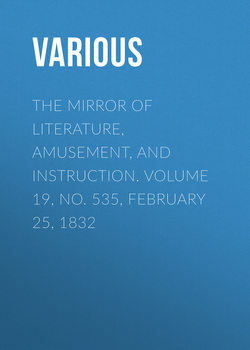Читать книгу The Mirror of Literature, Amusement, and Instruction. Volume 19, No. 535, February 25, 1832 - Various - Страница 2
GARDENS OF THE ZOOLOGICAL SOCIETY
ОглавлениеREGENT'S PARK
A visit to these Gardens is one of the most delightful of the rational recreations of the metropolis. The walk out is pleasant enough: though there is little rural beauty on the road, the creations of art assume a more agreeable appearance than in the city itself; and, with cottages, park-like grounds, and flourishing wood, the eye may enjoy a few picturesque groupings.
The Garden of the Society is one of the prettiest in the vicinity of the metropolis; the Menagerie is certainly the most important ever collected in this country. It is a charming sight to behold myriads of tiny flowers fringing our very paths, and little groves of shrubs and young trees around us; yet it is a gratification of the highest order, to witness the animals of almost every country on the earth assembled within a few acres; and it is indeed a sublime study to observe how beautifully the links in the great chain of nature are wrought, and how admirably are the habits and structure of some of these animals adapted to the wants of man, while all are subservient to some great purpose in the scale of creation. How clearly are these truths taught by the science of Zoology; and how attractively are they illustrated in the Menagerie of the Zoological Gardens. Consider but for a moment that the cat which crouches by our fireside is of the same tribe with "the lordly lion," whose roar is terrific as an earthquake, and the tiger who often stays but to suck the blood of his victims: that the faithful dog, "who knows us personally, watches for us, and warns us of danger," is but a descendant from the wolf, who prowls through the wintry waste with almost untameable ferocity. Yet how do we arrive at the knowledge of these interesting facts—but by zoological study.
Two of the Cuts in the annexed page will furnish our country friends with the improved plan of keeping the animals in large open cages. The first represents that of the Polar Bear, of strong iron-work, with a dormitory adjoining. The enclosed area is flagged with stone, and in the centre is a tank, or pool, of water, in which the bear makes occasional plungings. The present occupant is but small in comparison with the usual size of the species. "Its favourite postures," observes Mr. Bennett, "are lying flat at its whole length; sitting upon its haunches with its fore legs perfectly upright, and its head in a dependent position; or standing upon all fours with its fore-paws widely extended and its head and neck swinging alternately from side to side, or upwards and downwards in one continued and equable libration."1
The second Cut represents the tunnelled communication between the two Gardens, beneath the carriage-road of the Park. Above, the archway is a pediment, supported by two neat columns, and a terraced walk, with balustrades. The whole is handsomely executed in cement or imitative stone. The decorative vases are by Austin, of the New Road. A lion's head, in bold relief, forms an appropriate key-stone embellishment to the arch. The sloping banks are formed of mimic rock-work profusely intermingled with plants and flowers.
The third Cut is the Monkey House, of substantial iron-work, with dormitories and winter apartments in the rear. In fine sunny weather the monkeys may be here seen disporting their recreant limbs to the delight of crowds of visiters. Their species are too numerous but for a catalogue. Among them are the Negro and Sooty Monkeys,—the Mone Monkey: "the name of Monkey is supposed to be derived from the African appellation of this species, Mone corrupted into Monachus." Bonneted, pig-tailed, and Capuchin Monkeys; the last named from their dark crowns, like the capuch or hood of a Capuchin friar; and black and white-fronted Spider Monkeys, named from their great resemblance to large spiders.
By the way, there is an abundance of still life in the Gardens at this ungenial season. We find the Elephant, the Antelopes, and the Zebra, in their winter quarters, and their mightinesses, the large cats, as the lions, tiger, and leopards, accommodated with a snug fire. The tropical birds, as the parrots, maccaws, &c., have been removed from the extremity of the north garden to warmer quarters; and the hyaenas, leopards, and a host of smaller carnivorous quadrupeds have taken their places. The upper end is occupied by four roomy dens, with a lordly black-maned lion and a lioness, from Northern Africa; above them are a fine lioness and a leopard from Ceylon: these we take to have been among the recent arrivals from the Tower Menagerie.
1
The Gardens and Menagerie of the Zoological Society delineated. Vol. I.
